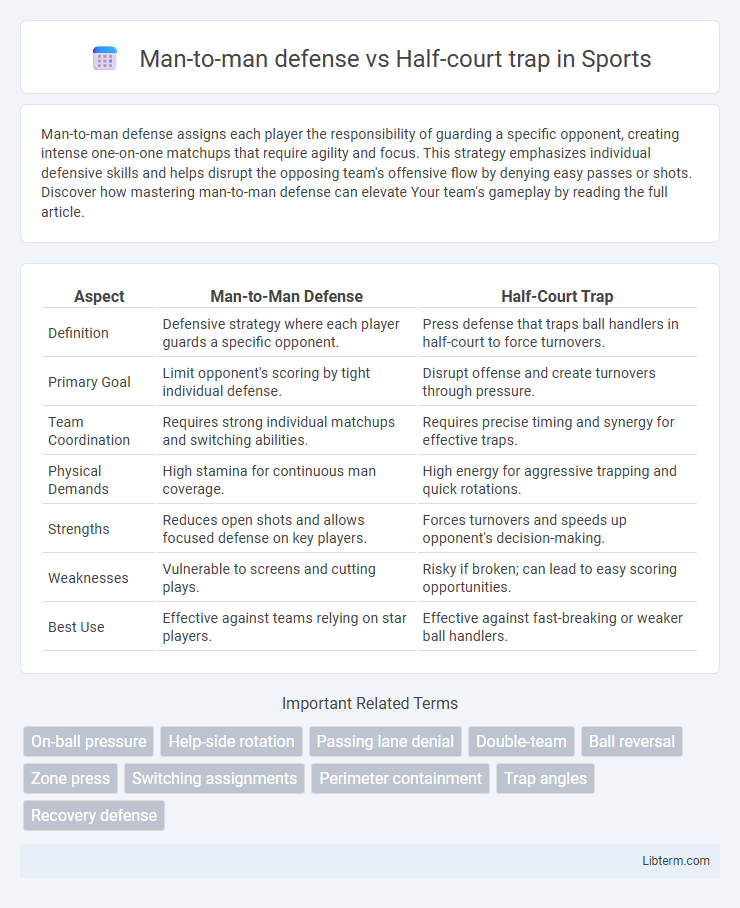Man-to-man defense assigns each player the responsibility of guarding a specific opponent, creating intense one-on-one matchups that require agility and focus. This strategy emphasizes individual defensive skills and helps disrupt the opposing team's offensive flow by denying easy passes or shots. Discover how mastering man-to-man defense can elevate Your team's gameplay by reading the full article.
Table of Comparison
| Aspect | Man-to-Man Defense | Half-Court Trap |
|---|---|---|
| Definition | Defensive strategy where each player guards a specific opponent. | Press defense that traps ball handlers in half-court to force turnovers. |
| Primary Goal | Limit opponent's scoring by tight individual defense. | Disrupt offense and create turnovers through pressure. |
| Team Coordination | Requires strong individual matchups and switching abilities. | Requires precise timing and synergy for effective traps. |
| Physical Demands | High stamina for continuous man coverage. | High energy for aggressive trapping and quick rotations. |
| Strengths | Reduces open shots and allows focused defense on key players. | Forces turnovers and speeds up opponent's decision-making. |
| Weaknesses | Vulnerable to screens and cutting plays. | Risky if broken; can lead to easy scoring opportunities. |
| Best Use | Effective against teams relying on star players. | Effective against fast-breaking or weaker ball handlers. |
Introduction to Defensive Basketball Strategies
Man-to-man defense involves each player guarding a specific opponent closely to prevent scoring opportunities, emphasizing individual accountability and quick rotations. The half-court trap applies intense pressure by positioning defenders to double-team ball handlers near midcourt, aiming to force turnovers and disrupt offensive rhythm. Both strategies are fundamental in basketball, offering distinct advantages in controlling the pace and defense intensity within the half-court setting.
What is Man-to-Man Defense?
Man-to-man defense is a basketball strategy where each defender is assigned a specific offensive player to guard closely throughout the game. This approach emphasizes individual accountability, physical pressure, and denying scoring opportunities by staying with the opponent wherever they move on the court. It contrasts with the half-court trap, which targets ball handlers collectively to force turnovers through aggressive, double-team pressure.
Key Principles of Man-to-Man Defense
Man-to-man defense relies on each player guarding a specific opponent, emphasizing on-ball pressure, denial of passing lanes, and strong help-side defense to prevent easy scoring opportunities. Communication and quick rotations are critical to adjusting screens and switching effectively without compromising defensive integrity. Maintaining proper stance, positioning, and anticipation allows defenders to contain their matchups while supporting teammates in disrupting offensive flow.
Understanding the Half-Court Trap
The half-court trap is a defensive strategy designed to pressure the offense immediately after the inbound pass in the defensive half, forcing turnovers and rushed decisions. Unlike man-to-man defense, where each defender guards a specific opponent, the half-court trap involves coordinated double-teaming and zone-like positioning to rapidly contain ball handlers. Successful execution relies on quick communication, anticipation of passing lanes, and intense physical pressure to disrupt the offensive flow and create scoring opportunities from turnovers.
Core Elements of Half-Court Trap
The half-court trap focuses on aggressive ball pressure and strategic positioning to force turnovers and disrupt offensive flow. Its core elements include trapping ball handlers in corners or near sideline boundaries, doubling defenders to create passing difficulties, and anticipating quick rotations to intercept passes. Effective communication and synchronized movements enable the defense to exploit offensive weaknesses within the half-court setting.
Strengths of Man-to-Man Defense
Man-to-man defense excels in applying relentless pressure on individual offensive players, enabling tighter control over their movements and reducing passing options. It enhances defensive accountability and allows for quick adjustments to exploit opponent weaknesses. This defensive strategy also fosters better communication and teamwork, increasing overall defensive effectiveness in preventing high-percentage shots.
Advantages of the Half-Court Trap
The half-court trap forces turnovers by applying intense pressure on ball handlers, disrupting the offensive rhythm and creating fast-break opportunities. It effectively slows down opponent offenses and increases the chance of scoring in transition. This defensive strategy capitalizes on aggressive positioning and communication to confuse passing lanes and force hurried decisions.
Weaknesses and Vulnerabilities of Each Approach
Man-to-man defense exposes vulnerabilities in dealing with quick ball movement, allowing skilled offensive players to exploit mismatches and create open shots or driving lanes. The half-court trap defense risks leaving perimeter shooters unguarded and can be beaten by precise, rapid passing that breaks the trap, leading to easy scoring opportunities. Both strategies require disciplined communication and situational awareness to mitigate their inherent weaknesses and prevent offensive breakdowns.
Choosing the Right Defense: Factors to Consider
Choosing the right defense between man-to-man and half-court trap depends on the opponent's offensive style, team speed, and defensive communication. Man-to-man defense excels in pressure on individual players and helps contain star scorers, while half-court trap disrupts ball handlers and forces turnovers with aggressive double-teaming in the backcourt. Coaches should evaluate player stamina, defensive versatility, and opponent ball-handling skills to optimize effectiveness and control game tempo.
Conclusion: Man-to-Man vs Half-Court Trap
Man-to-man defense offers personalized coverage, allowing defenders to closely guard individual opponents and adapt to offensive movements efficiently. In contrast, the half-court trap emphasizes aggressive double-teaming and pressure in a confined space to force turnovers and disrupt offensive rhythm. Choosing between these strategies depends on team strengths, with man-to-man providing reliable containment while the half-court trap thrives on creating chaos and quick possession changes.
Man-to-man defense Infographic

 libterm.com
libterm.com